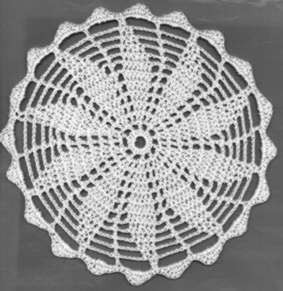Crochet Flower Doily/Coaster

Crochet Flower Doilies or Coasters are a delightful way to add a touch of charm to your home decor. These intricate and colorful creations can be both practical and decorative, offering a beautiful backdrop for your favorite vase or a cozy spot for your morning coffee. The intricate patterns and vibrant colors are sure to brighten up any room, making them a lovely addition to your living space.
Whether you're a seasoned crocheter or just starting out, creating these dainty flower doilies/coasters can be a fun and rewarding project that allows you to showcase your creativity and add a personal touch to your home.Size : 18 cm (7 inches) diameter
Material : Pearl cotton # 5, hook 1.7 mm (Boye steel #7) ; you can substitute with Cebelia #10 or equivalent cordonnet thread (but the gauge can slightly vary)
Stitches : ch, sl st, sc, dc, tr
Difficulty: easy/medium
Directions
Start with 8 ch, join ;
1. 20 sc in lp; join with sl st in first st.
2. (dc on sc; 2 ch; sk next sc) 10 times; join with sl st in first st.
3. * (2 dc) on dc, 1 ch, 1 dc in lp *; Repeat from * to * 9 times more; join with sl st in first st.
4. * 1 dc on first dc of two-dc group; (2 dc) on second one, 1 ch; 1 dc on single dc, 1 ch * ; Repeat from * to * 9 times more; join with sl st in first st.
5. * 1 dc on first dc of 3-dc group; (2 dc) on second one, 1 dc on third one, 1 ch; 1 dc on single dc, 1 ch * ; Repeat from * to * 9 times more; join with sl st in first st. .
6. * 1 dc on first dc of 4-dc group; 1 dc on second one, (2 dc) on third one, 1 dc on fourth one, 2 ch; 1 dc on single dc, 2 ch * ; Repeat from * to * 9 times more; join with sl st in first st. .
7 .* 1 dc on first dc of 5-dc group; 1 dc on second one, (2 dc) on third one, 1 dc on fourth one, dc on fifth one, 2 ch; 1 dc on single dc, 2 ch * ; Repeat from * to * 9 times more; join with sl st in first st.
8. * (dc on dc) 3 times, 2 dc closed together on next two dc, (dc on dc) twice , 3 ch, dc on single dc, 3 ch *; Repeat from * to * 9 times more; join with sl st in first st.
9. * (dc on dc) 2 times, 2 dc closed together on next two dc, (dc on dc) twice , 3 ch, dc on single dc, 3 ch *; Repeat from * to * 9 times more; join with sl st in first st.
10. * (dc on dc) 2 times, 2 dc closed together on next two dc, dc on dc , 4 ch, dc on single dc, 4 ch *; Repeat from * to * 9 times more; join with sl st in first st.
11. * dc on dc, 2 dc closed together on next two dc, dc on dc , 5 ch, dc on single dc, 5 ch*; Repeat from * to * 9 times more; join with sl st in first st.
12. * 2 dc closed together on next two dc, dc on dc , 6 ch, dc on single dc, 6 ch*; Repeat from * to * 9 times more; join with sl st in first st.
13. * 2 dc closed together on next two dc, 7 ch, dc on single dc, 7 ch *; Repeat from * to * 9 times more; join with sl st in first st.
14. * sc in next dc, (sc , 2 hdc, dc, 2 tr, dc, 2 hdc, dc) in next lp * ; Repeat from * to * 19 times more; join with sl st in first st, cut thread.
N.B.
- Always substitute (also if not explicitly said) first st in a row as follows:
- first sc with 1 ch, sc;
- first hdc with 2 ch;
- first dc with 3 ch;
- first tr with 4 ch...and so on;
- When you read "sl st to <location>", where the location is not immediately contiguous to last st, this means of course "an appropriate number of sl sts for reaching <location>".
- Also if I do not specify it, if you lasted prev row on a st (say st1), while you must start next row in another st (say st2), make an appropriate number of sl sts to reach st2.
